A Closer Look at Common Foot Deformities
Bunions and hammertoes are common yet often misunderstood foot deformities that can cause significant discomfort and mobility issues. Understanding their causes, symptoms, and treatment options is essential to effectively manage these conditions and improve foot health. This article explores the nature of bunions and hammertoes, outlines practical treatment strategies, and highlights preventive measures to maintain foot function and comfort.
What Are Bunions and Hammertoes?
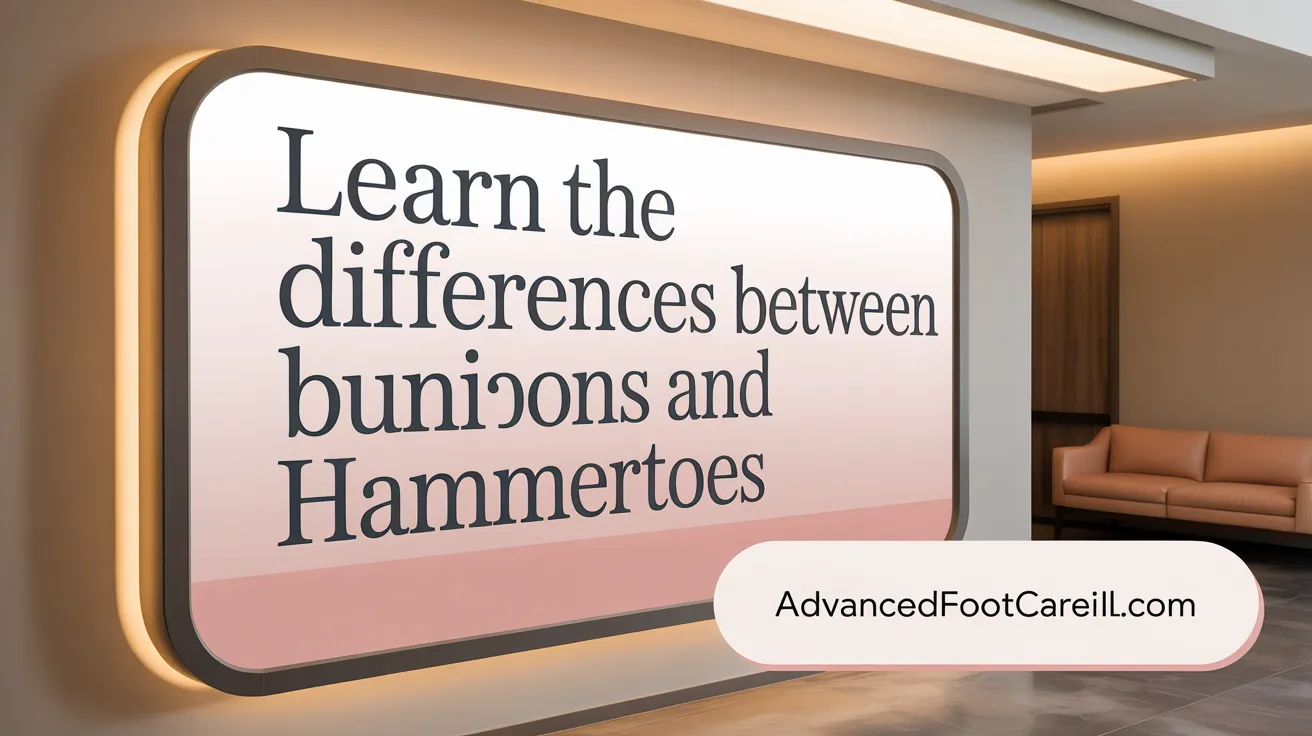
What are bunions and what symptoms do they cause?
Bunions, medically termed hallux valgus, are bony protrusions that form at the metatarsophalangeal (MTP) joint—the base of the big toe. This condition happens when the big toe leans inward toward the other toes, shifting the joint outward and causing a noticeable bump on the inside edge of the foot. Common symptoms include a visible swelling or bump, pain, stiffness, redness, inflammation, and difficulty moving the big toe. Additionally, friction from misalignment often leads to corns and calluses. Learn more about Bunions symptoms.
What are hammertoes and how do they develop?
Hammertoes are deformities affecting the lesser toes, typically the second, third, or fourth toes, wherein the middle joint bends downward, curling the toe into a hammer-like shape. They develop from chronic pressure and muscle imbalances caused by factors like ill-fitting shoes, foot structure issues, or health conditions including rheumatoid arthritis. Symptoms of hammertoes include visibly curled or bent toes, pain on the top of the toes or ball of the foot, swollen joints, and problems moving the affected toes. For detailed information, see Symptoms of hammertoes and Causes of hammertoes.
Differences in anatomical development and affected toes
Bunions form at the big toe's MTP joint due to bone misalignment leading to the toe pointing inward. In contrast, hammertoes involve deformity of the middle joint in the lesser toes, causing them to curl. Bunions primarily affect one joint at the big toe base, while hammertoes affect the second joint of smaller toes. This difference impacts both the appearance and the type of pain experienced. Explore more on Bunion foot mechanics and Hammer toe deformity overview.
Associated conditions and risk factors
Both conditions share common risk factors such as wearing tight, narrow, or high-heeled shoes and having a family history of foot deformities. Health issues like rheumatoid arthritis can contribute to both bunions and hammertoes by causing inflammation and joint damage. Women are more frequently affected, partly due to footwear choices. Additionally, foot structure anomalies, prolonged standing, or neuromuscular diseases may increase susceptibility. See more on Bunion risk factors and Risk factors for hammertoes.
Causes and Risk Factors Behind These Foot Conditions
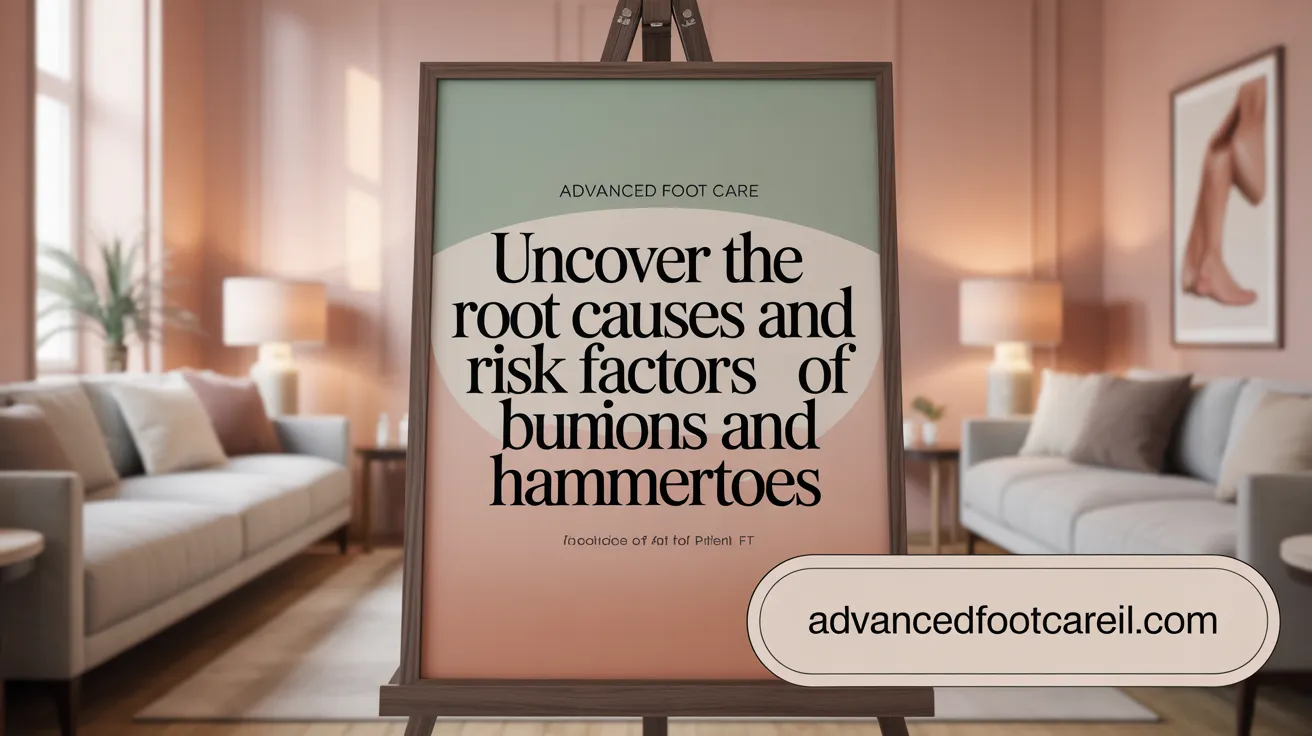
What causes bunions?
Bunions develop due to a mix of genetic, structural, and external factors. Inherited foot structure abnormalities, like flat feet or loose joints, set the stage for bunions. The condition is worsened by wearing tight, narrow, or high-heeled shoes that push the big toe toward the others, causing the bone at the base to protrude. What causes bunions, Bunions causes and risk factors, Bunion causes and contributing factors, Causes of bunions.
Additional causes include foot injuries and inflammatory conditions such as rheumatoid arthritis. Occupations involving long hours of standing or walking also place extra stress on the feet, increasing bunion risk. Women are at higher risk, not only because of footwear choices but also due to hormonal changes that loosen ligaments. Occupational risks for bunions, Family history and bunions, Bunion risk factors, Hormonal effects on bunions during pregnancy.
What causes hammertoes?
Hammertoes primarily arise from an imbalance in the muscles and tendons controlling toe position, leading to a bent or curled toe. Causes of hammertoes, Hammertoes causes.
Ill-fitting shoes, especially those with narrow toe boxes and high heels, exert pressure that forces toes out of alignment. Structural factors like high arches, flat feet, or longer toes contribute further. Health conditions such as diabetes, arthritis, neuromuscular diseases, and past trauma also predispose individuals to hammertoes. Hammertoes and footwear choices, Foot structure and hammertoe risk, Hammertoes and health conditions.
These influences cause tightening of tendons and muscles, locking the toe into a bent hammer-like shape. Hammertoes progression, Muscle shortening in toes.
Influence of Footwear and Lifestyle
Both bunions and hammertoes share risk factors related to footwear. Narrow, pointed shoes and high heels increase pressure on toes and joints, promoting deformities. Lifestyle factors, including prolonged standing and walking, exacerbate these conditions. How Shoes Affect Bunions, Footwear and hammertoes, Importance of proper footwear.
Role of Health Conditions
Chronic diseases such as rheumatoid arthritis and diabetes impair foot function and increase susceptibility to bunions and hammertoes. These conditions can cause inflammation, joint damage, and neuropathy, leading to altered foot mechanics. Bunions and arthritis connection, Impact of Neuromuscular Diseases on Feet, Foot arthritis and bunions, Diabetes and rheumatoid arthritis effects on hammertoes.
Impact of Occupation and Hormonal Changes
Jobs requiring extended standing, like teaching and nursing, increase mechanical stress on toes. Women’s hormonal fluctuations, particularly during pregnancy, loosen foot ligaments, raising bunion risk. Occupational Foot Stress, Hormonal effects on bunions during pregnancy, Bunion risk factors.
These diverse factors interplay, contributing to the development and progression of bunions and hammertoes.
Diagnosis and Non-Surgical Treatment Options
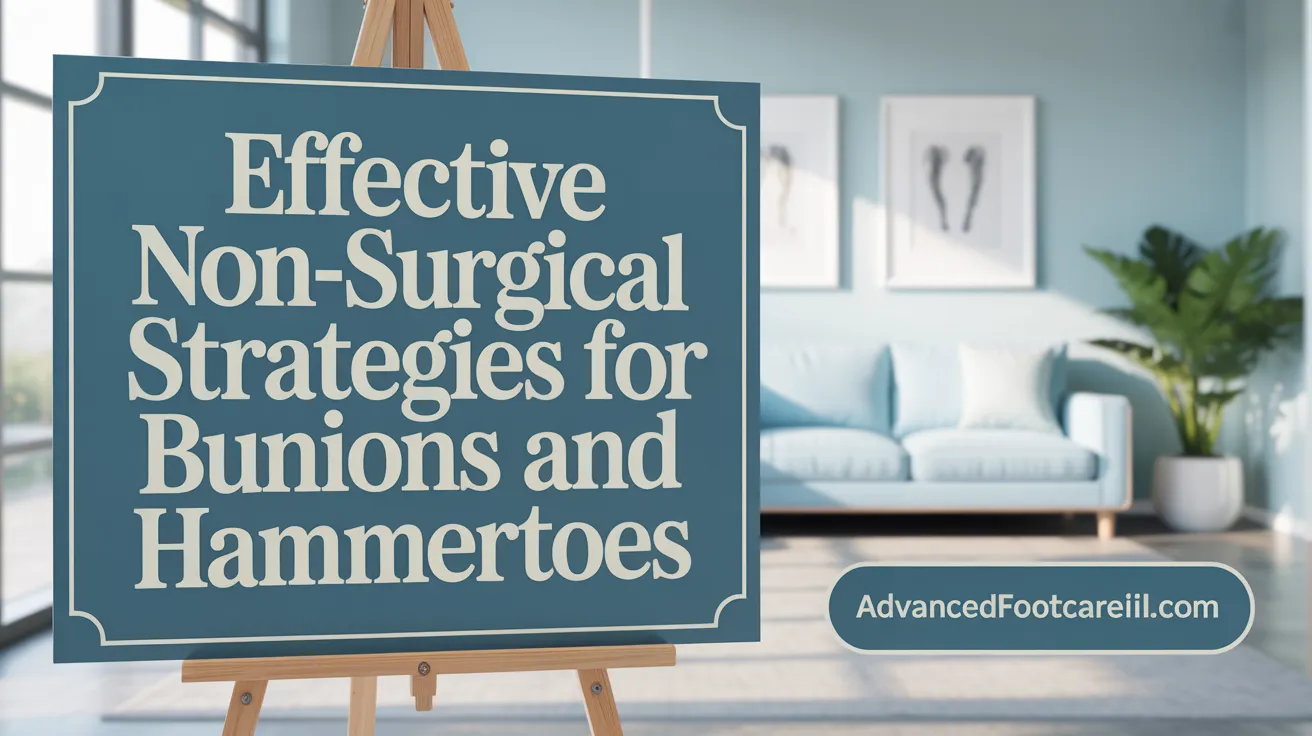
How Are Bunions Diagnosed and Treated Without Surgery?
Bunions are primarily diagnosed through a thorough physical examination, which highlights the visible bump and assesses symptoms such as pain or limited toe motion. X-rays are commonly used to confirm the diagnosis and evaluate the alignment and severity of the bone deformity. For treatment without surgery, the focus is on relieving pressure and managing pain. This includes wearing shoes that are wide and have a roomy toe box to avoid squeezing the big toe joint.
Additional non-surgical options include using bunion pads or orthotic inserts to cushion the area and correct foot mechanics. Applying ice packs can help reduce swelling, and over-the-counter NSAIDs (nonsteroidal anti-inflammatory drugs) like ibuprofen provide pain relief and inflammation control. Physical therapy is also beneficial, emphasizing exercises to maintain joint flexibility and strengthen foot muscles, potentially slowing bunion progression. Though these conservative approaches ease symptoms and improve function, they do not reverse the actual bone deformity.
What Are the Conservative Treatments for Hammertoes?
Hammertoes are similarly evaluated through physical exams and sometimes X-rays to check toe joint flexibility and bone structure. Early treatment aims at easing pressure on the bent toes and includes switching to comfortable footwear featuring a wide, deep toe box with soft uppers to accommodate the curled toes.
Protective pads or splints can shield toes from friction and reduce discomfort. Custom orthotic devices help redistribute foot pressure, preventing exacerbation of the deformity. Pain management often involves NSAIDs, and targeted toe exercises—such as towel scrunches exercises and marble pickups—can improve toe flexibility and muscle strength, which may help prevent the toe from becoming rigid.
Together, these conservative methods can successfully manage symptoms and delay or avoid the need for surgical correction when implemented early and consistently.
Surgical Interventions: When and What to Expect
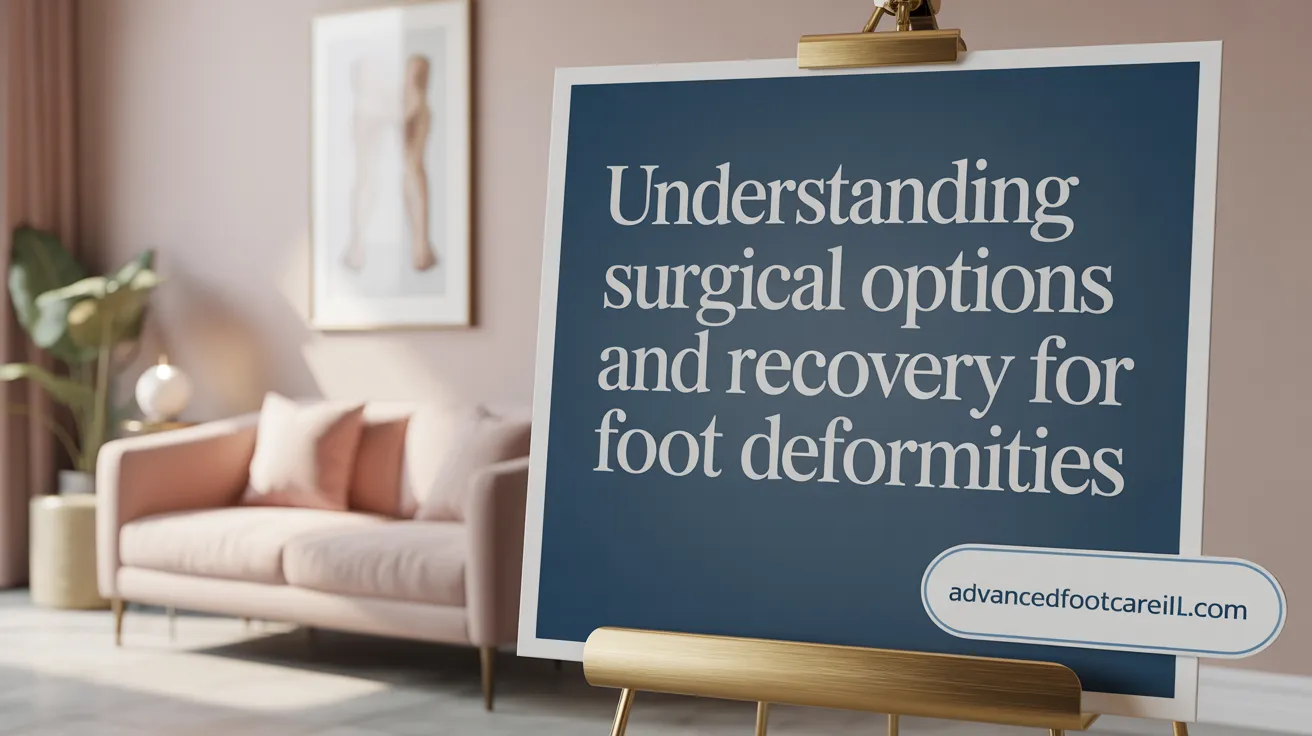
When is bunion surgery recommended and what does it involve?
Bunion surgery is recommended when severe, persistent pain significantly interferes with daily activities and conservative treatments for bunions fail to provide relief. The surgical goal is to remove the painful bony bump and correct the toe alignment. Procedures include bunionectomy (removal of the bony protrusion), osteotomy (cutting and realigning the bones), arthrodesis (joint fusion, often used in advanced arthritis), and soft tissue repair.
What surgical options exist for hammertoes and what is the recovery process?
Hammertoe surgery is typically considered when the toe becomes rigid and painful, resistant to nonsurgical treatment for hammertoe. Surgery varies by severity and may involve tendon lengthening or transfer, joint resection, bone removal, or fusion to straighten the affected toe. These procedures are mainly outpatient and often performed under local anesthesia or nerve blocks, as detailed in hammertoe surgery recovery.
Minimally invasive techniques
Minimally invasive surgical approaches are becoming more common for both bunions and hammertoes. These techniques involve smaller incisions, less tissue disruption, reduced post-operative pain, and faster recovery times compared to traditional open surgery, as noted in minimally invasive bunion surgery and minimally invasive hammertoe surgery.
Post-operative care and recovery times
Following surgery, patients are advised to keep the foot elevated and avoid putting full weight on it initially. Wearing special protective footwear or boots is common to protect the surgical site while healing. Physical therapy may be recommended to regain strength and mobility. Recovery timelines vary but typically range from several weeks to a few months; bunion surgery recovery can extend up to six months depending on the procedure.
Risks and complications
As with all surgeries, there are potential risks including infection, nerve or blood vessel injury, swelling, stiffness, delayed healing, recurrence of deformity, and toe instability. Discussing these risks thoroughly with a surgeon before the procedure is crucial for informed decision-making, as outlined in bunion surgery risks and considerations.
Preventing Bunions and Hammertoes: Practical Tips
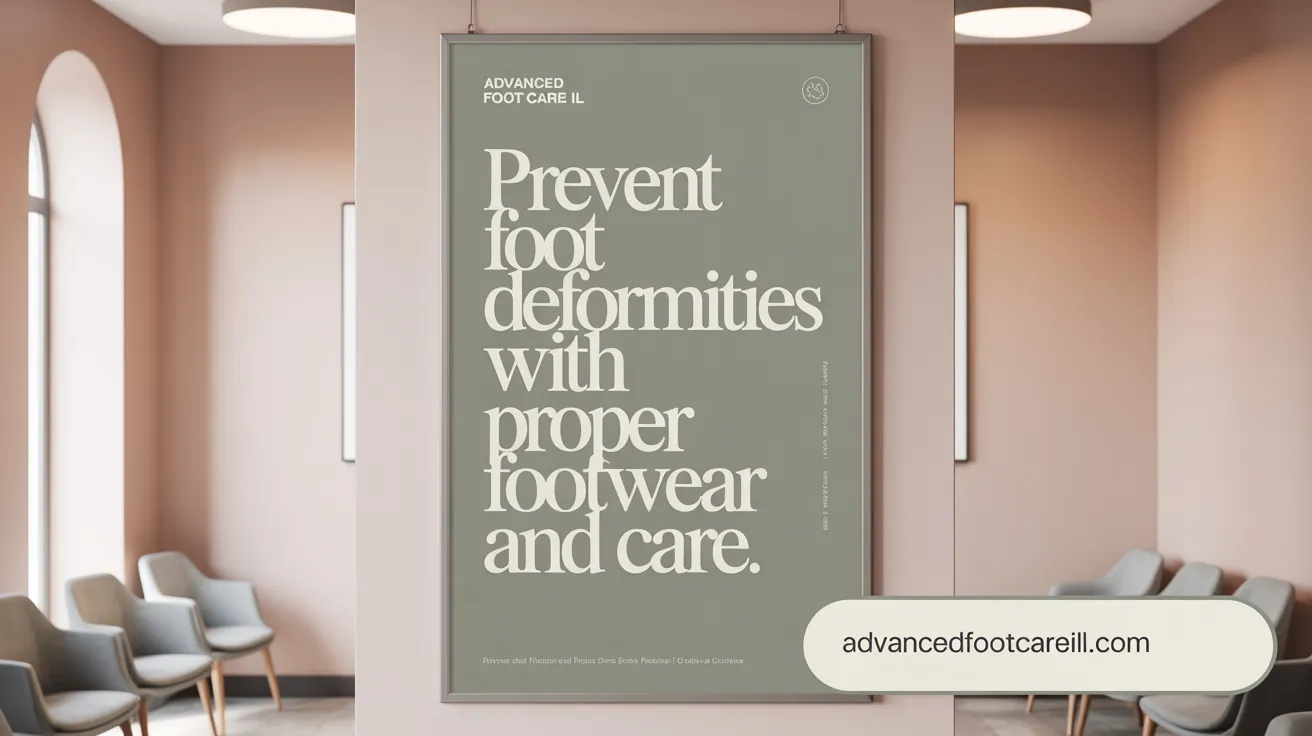
How can bunions and hammertoes be prevented?
Prevention focuses mainly on wearing well-fitting shoes that offer ample space for the toes. Avoid shoes that are narrow, pointed, or have high heels, as these can crowd the toes and contribute to deformities. When shopping for shoes, it's best to try them on at the end of the day when feet are slightly swollen to ensure proper fit (Preventing bunions and hammertoes).
Proper footwear choices and shoe fitting
Choose shoes with wide toe boxes and good arch support to reduce pressure on toes and foot joints. Low-heeled shoes are recommended over high heels, which can increase stress on the front of the foot and exacerbate deformities (Choosing shoes for bunions, Proper shoe fit for bunions, Proper shoe fit for hammertoe prevention). Regularly measuring feet is important as foot size and shape can change over time (Foot measures for shoe fitting.
Foot care and exercise routines
Incorporate foot exercises into daily routines, such as toe scrunches exercises, curls, picking up small objects like marbles, and towel scrunches. These exercises improve flexibility, strengthen foot muscles, and help maintain proper alignment of toes and joints, potentially preventing or slowing the progression of bunions and hammertoes (Bunion exercises, Exercises to Improve Hammertoes, Toe exercises for foot flexibility and strength).
Early detection and medical consultation
Monitoring feet for early signs—such as pain, swelling, redness, or visible bumps—helps in early detection. Seeking prompt medical advice from a podiatrist or healthcare provider allows for timely interventions that may prevent deformities from worsening (Early bunion consultation, Early diagnosis of hammertoe).
Lifestyle modifications to reduce risk
Maintaining a healthy body weight reduces pressure on the feet. Managing underlying health conditions such as arthritis and diabetes is also crucial since inflammation and nerve issues can increase the risk of toe deformities (Preventing bunions, Foot care for hammertoe).
Together, these strategies form an effective approach to minimizing the chances of developing bunions and hammertoes, as well as controlling symptoms if they already exist.
Maintaining Foot Health: The Road Ahead
Bunions and hammertoes, while common, need not compromise one’s quality of life. Through a combination of vigilant preventive measures, appropriate footwear choices, regular exercises, and timely medical intervention, individuals can effectively manage symptoms and slow progression. For many, conservative treatments suffice, but addressing severe cases with surgical options provides significant relief and restores mobility. Early recognition and proactive care remain key to healthy feet and continued mobility.
